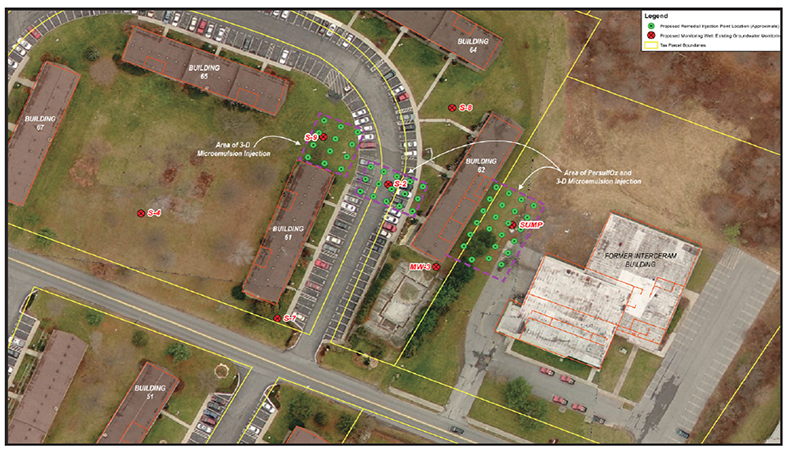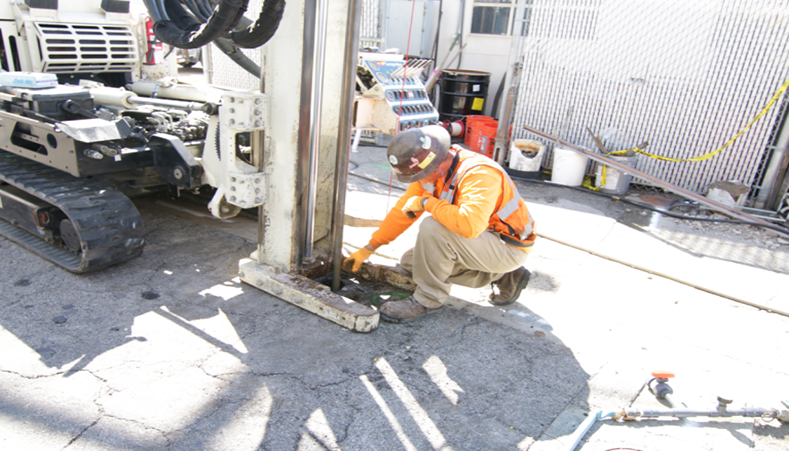Biodegradation Successfully Treats High Levels of PCE/TCE Contamination
Combined Remedies Used to Remediate Active Dry Cleaner in Northern California
Project Highlights
- Pilot study used enhanced biodegradation coupled with bioaugmentation to treat high PCE levels.
- High PCE levels above 5,000 ug/L were detected in groundwater.
- Regenesis optimized injection of the bioamendments into the target treatment zone.
- Significant contaminant reduction resulting from enhanced biodegradation within six months
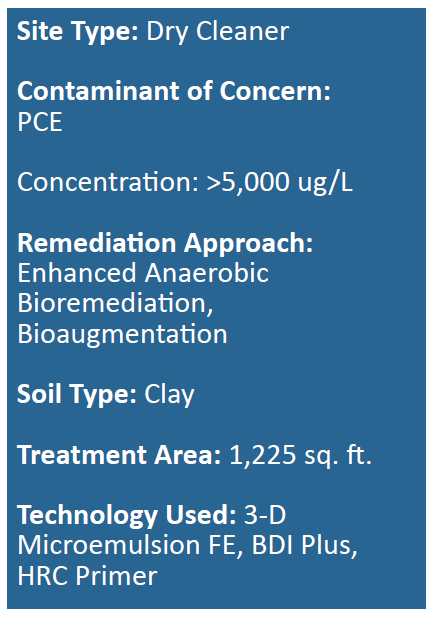
Project Summary
This project was located at an active dry cleaner in northern California. The site had elevated levels of PCE in groundwater due to releases over a period of approximately 60-years. Enhanced anaerobic biodegradation (EAB) was chosen to remediate the site. A pilot study program was implemented using a combination of 3-D Microemulsion®, HRC® Primer and BDI® Plus. Significant contaminant reductions were observed within six months of the first application.
Remediation Approach
An in situ EAB pilot study program was implemented to address elevated levels of PCE concentrations in middle zone groundwater just north of site. 3-D Microemulsion, HRC Primer and BDI Plus were applied through 15 bore holes to depths of 60 feet. Early injection attempts posed challenges due to the formation not accepting the required volume (surfacing). Regenesis provided a modified design reducing the amount of water needed for 3-D Microemulsion and suggested an alternative injection approach in the field which allowed for a more efficient injection within the target treatment zone.
Technology Description
3-D Microemulsion is an engineered electron donor material that offers a novel 3-stage electron donor release profile, pH neutral chemistry and is delivered on-site as a factory emulsified product.
HRC Primer is a less viscous version of the standard Hydrogen Release Compound (HRC) product. It is a thinner, water-like compound that is typically injected into an aquifer where it releases lactic acid at a rate faster than standard HRC (several weeks), but at a slower, more controlled rate than dispersing aqueous simple sugar solutions or straight lactic acid (several days).
Bio-Dechlor INOCULUM® Plus is an enriched natural microbial consortium containing species of Dehalococcoides sp. (DHC). This microbial consortium has since been enriched to increase its ability to rapidly dechlorinate contaminants during in situ bioremediation processes.
Successful Bioremediation at a Former Air Force Base Fire Training Area
Carbon Tetrachloride Concentrations Reduced Below Treatment Goal within 8 Months
Project Highlights
- Air Force Base contaminated with high levels of carbon tetrachloride due to on-site firefighting training.
- 97% reduction in contaminant within three months.
- Carbon tetrachloride reduced to below detection limits.

Project Summary
Training exercises at Texas Air Force Base resulted in an impact to soil and groundwater by trichloroethylene (TCE) and carbon tetrachloride. A monitored natural attenuation study conducted indicated that chlorinated solvents at the plume would naturally decline to acceptable levels after 30 years of monitoring.
After over 14 years of monitoring, contaminant reductions were not proceeding as quickly as predicted and additional remediation was advised. It was determined that limited anaerobic activity was present and biostimulation was a viable option. A pilot test was conducted on-site. The objective of the project was to determine the feasibility of injection into the shallow, discontinuous groundwater unit. The pilot test was also designed to determine if the residual TCE and carbon tetrachloride could be biodegraded through enhanced bioremediation and reduced to below 5 ppb (the Texas Risk Reduction Program limit).
Remediation Approach
3-D Microemulsion® was injected into 30 points at the site; approximately 380 gallons of the product was applied per boring at the site. Initial results indicated a significant reduction in concentrations of parent chemicals – carbon tetrachloride was reduced by 95% within 1 month post-injection and 97% within 3 months of injection within the source area. A monitoring well 50-feet downgradient of the source area experienced a 69% reduction by the third month as 3-D Microemulsion began to reach the well location.
Follow-up injections were applied downgradient of the source area and also in a barrier configuration several hundred feet dowgradient of the source were implemented about 6 months after the pilot test. The combination of the pilot test and full-scale application resulted in a 97.8% reduction in carbon tetrachloride 8 months post-injection with chloroform, methylene chloride, and chloromethane remediation daughter products on a downward trend. High TCE concentrations were effectively treated as well with TCE peaking after injections to 126 ppb and then being reduced within a 3-month period to 0.2 ppb.
Technology Description
3-D Microemulsion is an engineered electron donor material that offers a novel 3-stage electron donor release profile, pH neutral chemistry and is delivered on-site as a factory-emulsified product.
REGENESIS® Achieves MCL Cleanup Goals at New York Manufacturing Facility
cVOC Contamination Successfully Treated Using PersulfOx® and 3-D Microemulsion®
Project Highlights
- 99% reduction of target compounds achieved on-site
- TCE levels reduced from 8,000 ug/L to <5 ug/L to meet site goals
- Integrated remediation approach using PersulfOx® and 3-D Microemulsion® (3DME)
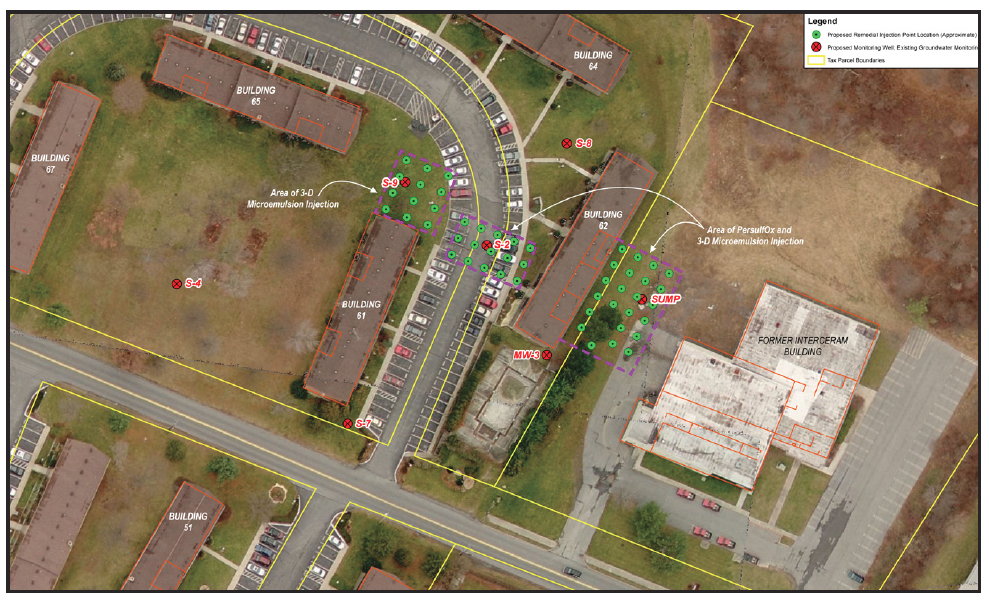
Project Summary
A manufacturing facility in New York was contaminated with high levels of chlorinated solvents. TCE levels were as high as 8,000 ug/L. A combined remedies approach was established to address the migrating plume. The goal of the application design was to reduce cVOCs in the source area, reduce potential for vapor intrusion and address any cVOCs that may migrate into the area downgradient of the manufacturing facility.
An integrated remediation strategy using PersulfOx and 3DME was implemented on-site. Two PersulfOx applications were completed. Results from the In Situ Chemical Oxidation (ISCO) treated area showed >99% reduction of target compounds. A total of 11,600 pounds of PersulfOx was applied on-site. 3DME was applied to enhance anaerobic biodegradation in downgradient locations and within the PersulfOx-treated area. A total of 8,400 pounds of 3DME was applied. While groundwater contamination in the ISCO treated area was reduced to clean-up standards, the goal of the 3DME application was strictly preventative. The client wished to address any potential plume migration from any cVOCs that may be present beneath the building.
Technology Description
PersulfOx is a sodium persulfate-based chemical oxidation technology which destroys both hydrocarbon and chlorinated solvent-type contaminants in the subsurface. PersulfOx contains a built-in catalyst which activates the persulfate component and generates contaminant-destroying free radicals without the need for the addition of a separate activator.
3-D Microemulsion is an engineered electron donor material that offers a novel 3-stage electron donor release profile, pH neutral chemistry and is delivered on-site as a factory-emulsified product.
Results
The use of PersulfOx safely and effectively reduced TCE levels to regulatory standards providing a 99% reduction of cVOC’s achieved on-site. In addition, the integration of 3DME as a precautionary safety measure addressed the potential for plume migration that was thought to be present.
ISCO/ERD Treat PCE Contamination at Indiana Dry Cleaner
Remediation Plan Addresses Concentrations Below Facility and Downgradient
Project Highlights
- PersulfOx utilized subslab near the source to inhibit vapor issues within the building.
- Combined remediation plan addressed impacts both below the building and downgradient of the facility.
- PCE contamination was nearly depleted and TCE levels below 10 ppb were observed.
- The site is currently being monitored to demonstrate plume stability with approximately 3-4 more monitoring events prior to site closure.
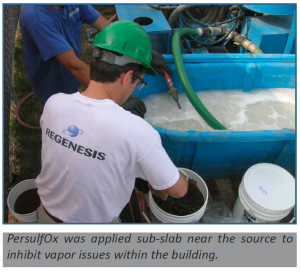
Project Summary
A release of PCE from a former dry cleaning operation in Indianapolis resulted in groundwater contamination below the facility and downgradient. Contamination impacts were also observed in shallow fill below the concrete slab. Along with the groundwater/soil contamination, vapor intrusion was also detected within the facility and adjacent spaces in the strip mall. A combination of enhanced reductive dechlorination (ERD) and in situ chemical oxidation (ISCO) was used for remedial action. Analytical results obtained indicate nearly complete reduction of PCE and less than 10 ppb of TCE in all wells. Currently, elevated VC concentrations in two wells were observed but reductions are expected as the ERD process is completed.
Remediation Approach
PersulfOx® Catalyzed Persulfate was injected below the floor slab of the dry cleaner to inhibit vapor production within the facility and adjacent spaces. 3-D Microemulsion® and Bio-Dechlor INNOCULUM® Plus were injected into the uppermost water-bearing area below the dry cleaner and into two areas downgradient on either side of the building. Supplemental ERD injections were applied in two areas approximately 9 months after the initial injection to address minor sand stringers that were contributing to continued contamination impacts. The supplemental injection resulted in immediate elimination of PCE/TCE and a rapid production of VC. The site is currently being monitored to demonstrate plume stability with approximately 3-4 more monitoring events prior to site closure.
Technology Description
PersulfOx is a sodium persulfate-based chemical oxidation technology which destroys both hydrocarbon and chlorinated solvent-type contaminants in the subsurface. PersulfOx contains a built-in catalyst which activates the persulfate component and generates contaminant-destroying free radicals without the need for the addition of a separate activator.
3-D Microemulsion is an engineered electron donor material that offers a novel 3-stage electron donor release profile, pH neutral chemistry and is delivered on-site as a factory-emulsified product.
Bio-Dechlor INOCULUM Plus is an enriched natural microbial consortium containing species of Dehalococcoides sp. (DHC). This microbial consortium has since been enriched to increase its ability to rapidly dechlorinate contaminants during in situ bioremediation processes.
ISCO/ERD Treat PCE Contamination at Indiana Dry Cleaner
Remediation Plan Addresses Concentrations Below Facility and Downgradient
Project Highlights
- PersulfOx utilized subslab near the source to inhibit vapor issues within the building.
- Combined remediation plan addressed impacts both below the building and downgradient of the facility.
- PCE contamination was nearly depleted and TCE levels below 10 ppb were observed.
- The site is currently being monitored to demonstrate plume stability with approximately 3-4 more monitoring events prior to site closure.
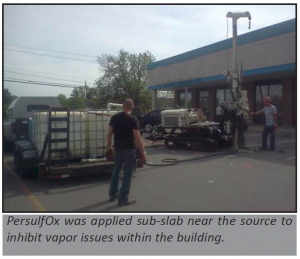
Project Summary
A release of PCE from a former dry cleaning operation in Indianapolis resulted in groundwater contamination below the facility and downgradient. Contamination impacts were also observed in shallow fill below the concrete slab. Along with the groundwater/soil contamination, vapor intrusion was also detected within the facility and adjacent spaces in the strip mall. A combination of enhanced reductive dechlorination (ERD) and in situ chemical oxidation (ISCO) was used for remedial action. Analytical results obtained indicate nearly complete reduction of PCE and less than 10 ppb of TCE in all wells. Per the recent sampling event, VC concentrations have dropped in all wells. Monitoring is ongoing.
Remediation Approach
PersulfOx® Catalyzed Persulfate was injected below the floor slab of the dry cleaner to inhibit vapor production within the facility and adjacent spaces. 3-D Microemulsion® and Bio-Dechlor INNOCULUM® Plus were injected into the uppermost water-bearing area below the dry cleaner and into two areas downgradient on either side of the building. Supplemental ERD injections were applied in two areas approximately 9 months after the initial injection to address minor sand stringers that were contributing to continued contamination impacts. The supplemental injection resulted in immediate elimination of PCE/TCE and a rapid production of VC. The site is currently being monitored to demonstrate plume stability with approximately 3-4 more monitoring events prior to site closure.
Technology Description
PersulfOx is a sodium persulfate-based chemical oxidation technology which destroys both hydrocarbon and chlorinated solvent-type contaminants in the subsurface. PersulfOx contains a built-in catalyst which activates the persulfate component and generates contaminant-destroying free radicals without the need for the addition of a separate activator.
3-D Microemulsion is an engineered electron donor material that offers a novel 3-stage electron donor release profile, pH neutral chemistry and is delivered on-site as a factory-emulsified product.
Bio-Dechlor INOCULUM Plus is an enriched natural microbial consortium containing species of Dehalococcoides sp. (DHC). This microbial consortium has since been enriched to increase its ability to rapidly dechlorinate contaminants during in situ bioremediation processes.
Combined Remedies Treatment Results in a $650,000 Cost Savings for End User
Project Highlights
- By implementing this strategy with a clear path to closure, KERAMIDA saved their client approximately $650,000 versus the alternative containment plan. KERAMIDA’s sophisticated and aggressive remedial approach matched the technologies (ISCO, ISCR, ERD) to the technical challenges at the site.
- PCE was virtually eliminated in most other impacted wells, and continued evidence of reductive dechlorination is ongoing.
- Project currently in the monitoring phase to establish plume stability for closure.
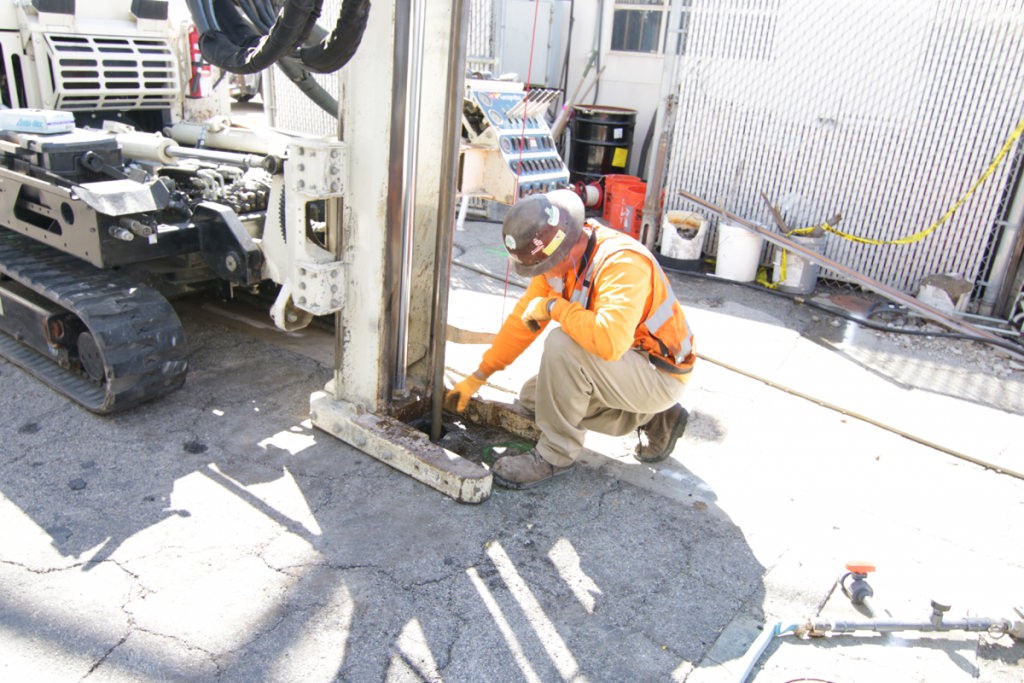
Project Summary
A PCE spill from a 55 gallon drum in the late 1980s contaminated a manufacturing site in Indiana. Contaminated soil was excavated in the spill area and a pump and treat interceptor system was installed downgradient of the plume. The system continued to operate intermittently throughout the 1990s. A previous consultant had submitted a remediation work plan proposing the use of a permeable reactive barrier. However, the plan was rejected because the intended goal was remedial closure, not containment. KERAMIDA proposed a combined in-situ chemical oxidation (ISCO)/enhanced reductive dechlorination (ERD) approach focusing on the spill area (source) and the downgradient, on-site plume, with a small injection off-site. The remediation plan was approved and the injection was completed in November 2013. KERAMIDA’s cost to closure is likely to be achieved for less than $500,000 – saving $650,000-800,000 over the life of the project. (The rejected remediation plan from the previous consultant had an estimated cost of $1.3 million with no plan for closure.)
Remediation Approach
The combined remedies treatment included an initial application of PersulfOx® Catalyzed Persulfate in the source area with subsequent applications of 3D Microemulsion® (3DME), BioDechlor INNOCULUM® Plus (BDI-Plus) and Chemical Reducing Solution (CRS®). In addition, 3DME and BDI-Plus were applied in two downgradient areas of the plume. Groundwater monitoring performed in the eight months since injection indicates dramatic reductions in PCE concentrations. Within the source area, an initial PCE concentration of approximately 70,000 ppb was reduced to 278 ppb (with a corresponding increase in cis-1,2-DCE, which is currently being degraded). PCE was virtually eliminated in most other impacted wells and evidence of reductive dechlorination is ongoing.
Technology Description
PersulfOx is a sodium persulfate-based chemical oxidation technology which destroys both hydrocarbon and chlorinated solvent-type contaminants in the subsurface. PersulfOx contains a built-in catalyst which activates the persulfate component and generates contaminant-destroying free radicals without the need for the addition of a separate activator.
CRS is an iron-based amendment for in situ chemical reduction (ISCR) of halogenated hydrocarbon contaminants such as chlorinated ethenes and ethanes.
3-D Microemulsion is an engineered electron donor material that offers a novel 3-stage electron donor release profile, pH neutral chemistry and is delivered on-site as a factory-emulsified product.
Bio-Dechlor INOCULUM Plus is an enriched natural microbial consortium containing species of Dehalococcoides sp. (DHC). This microbial consortium has since been enriched to increase its ability to rapidly dechlorinate contaminants during in situ bioremediation processes.
Historic California Site Treated with 3-D® Microemulsion and HRC® Primer
Project Highlights
- Site was open for over 20 years with the Central Coast Regional Board
- Immediate results showed a TCE decrease from 2,260 ppb to 12 ppb
- Site is currently under review for closure
- Cost per cubic yard was under $10 per cubic yard complete turn-key
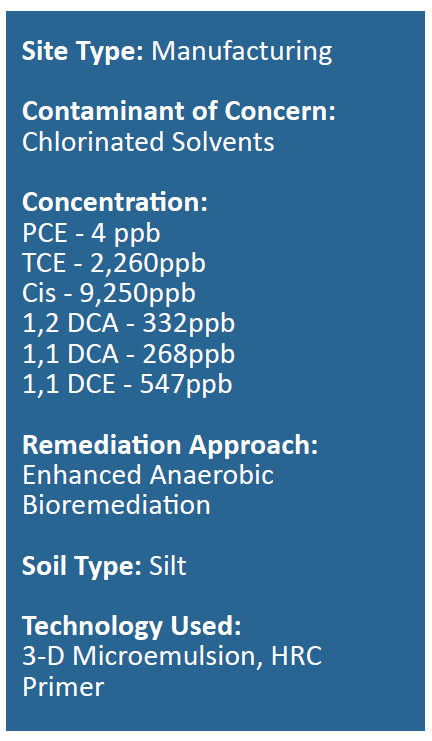
Project Summary
This California site has been open with the Central Coast Regional Board for over 20 years with groundwater VOC concentrations thousands of times higher than the MCL. The site also had limited metal concentrations above MCL. A remediation plan was created to treat the groundwater plume using enhanced anaerobic bioremediation via Hydrogen Release Compound (HRC®) Primer and 3-D Microemulsion®. Immediate results showed a decrease in TCE concentrations from 2,260 ppb to 12 ppb.
Remediation Approach
Seven separate designs were developed to treat the 60,450-square-foot area. Several water bearing zones were treated throughout the site. Initial concerns for treatment included the possibility of a buildup of methane in the soil gas. However, because 3-D Microemulsion is a controlled-release, high-volume electron donor, no methane issues were observed. Cost for the product and application was less than $10 per cubic yard and the site is currently under review for closure.
Technology Description
3-D Microemulsion is an engineered electron donor material that offers a novel 3-stage electron donor release profile, pH neutral chemistry and is delivered on-site as a factory-emulsified product.
HRC Primer is a less viscous version of the standard Hydrogen Release Compound (HRC) product. It is a thinner, water-like compound that is typically injected into an aquifer where it releases lactic acid at a rate faster than standard HRC (several weeks), but at a slower, more controlled rate than dispersing aqueous simple sugar solutions or straight lactic acid (several days).
PlumeStop Application Pilot Study: Former Dry Cleaner Site, USA
Approach
A beta-test pilot evaluation of PlumeStop™ performance was conduced on chlorinated solvent groundwater contamination at a former dry cleaner site. PlumeStop was applied in conjunction with the slow-release electron donor, HRC® and the microbial bioaugmentation dechlorinator inoculum, BDI® for the treatment of residual PCE (550 μg/L). The test was conducted around a single well. Conditions prior to the test were aerobic (ORP +254 mV; DO 44%). Multiple parameters were monitored from groundwater samples to explore lines or evidence of solvent fate / degradation.
2m 27s reading time
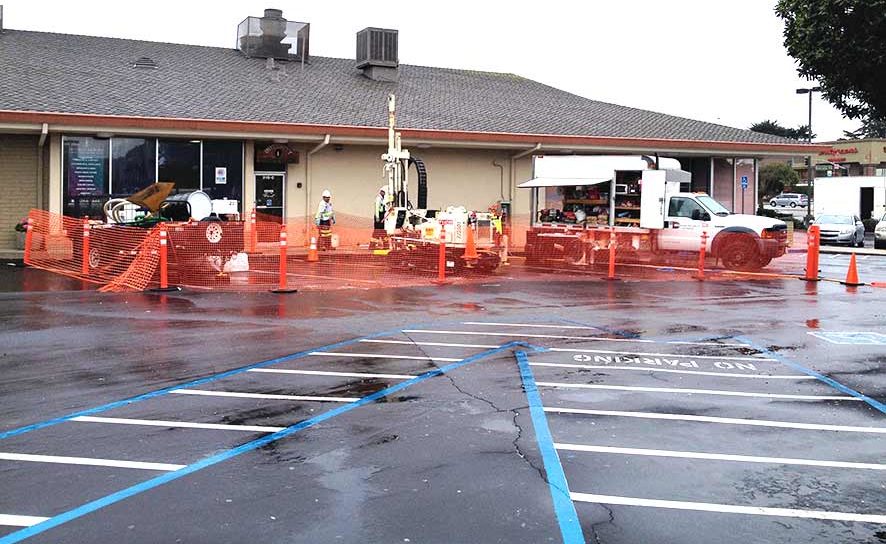
Results
Post-treatment solvent concentrations in groundwater were reduced by over 99% to non-detect (<5μg/L) by the first sampling round (19 days). Microbial quantitative array data revealed marked increases in reductive dechlorinator species from baseline conditions in the months following reagent application (several hundred percent or more). (Baseline taken as immediately post-inoculation for species included in BDI). Moreover, functional enzymes for dechlorination of PCE through to ethene similarly increased over the same period (i.e. including specific genes for the degradation of TCE, DCE and vinyl chloride). Through this time, groundwater concentrations of PCE and daughter products remained below detection limits (>15 months post treatment).
Electron donor status and redox potential post-application quickly stabilised at near-optimal conditions ( 150mV +/- 30 mV), with rapid decreases in competing electron acceptors observed within the first sampling intervals, albeit with some interplay with available iron, possibly reflecting an electron shuttle dynamic with iron naturally present within the formation. The redox remained below methanogen activity thresholds – methanogen numbers did not share the trends observed in dehalorespirers, and in fact were detected above quantitation thresholds (2 – 30 cells /ml) in one sampling event only, at significantly lower cell counts than Dehalococcoides (94 vs. 12,200 cells/ml).
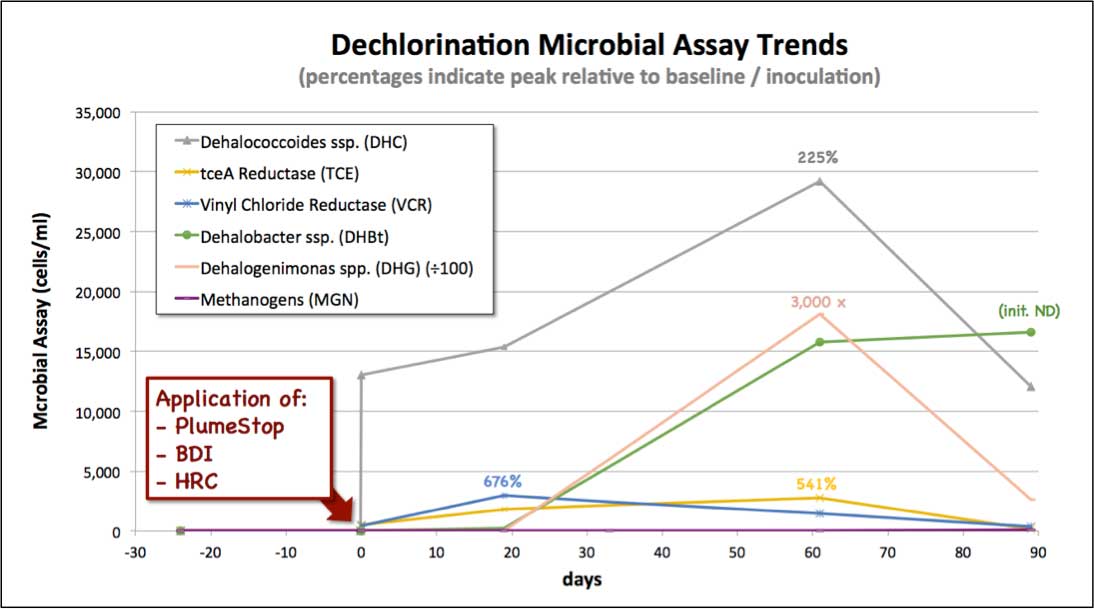
Discussion
The continued expansion and proliferation of an active dechlorinating microflora in the months following inoculation are indicative of solvent biodegradation through this time. That no solvent was present above detection limits in groundwater through the same period would indicate the degradation to be proceeding ostensibly from the sorbed phase (i.e. PlumeStop/water interface). This would be consistent with the PlumeStop bio-matrix hypothesis. It is also of note that the dechlorinator numbers and activity peaked at approximately sixty days and declined thereafter. Although the data set is limited, this trend would be consistent with the presumed depletion of the solvent through degradation, the starting concentration having been only 550 μg/L.
Conclusion
These data provide lines of evidence for post-sorption degradation of the target solvents on the PlumeStop, and would further indicate that methanogenic conditions are not necessary for complete reductive dechlorination activity through to ethene. Moreover, all data were obtainable from groundwater samples presenting a straightforward means of performance tracking via wells using the lines of evidence approach.
What’s Special
- Depletion of groundwater solvent concentrations to non-detect within 19 days
- All Contaminants of Concern (PCE and daughter products) are remaining below detection limits 15 months post application (and counting)
- Multiple lines of evidence for post-sorption solvent degradation
- All data obtainable from groundwater samples alone
- No generation of methane / competition from methanogens
PlumeStop® Applied to Former Electronics Facility in Indiana Achieves 99.9% Reduction in 2 Months
Project Highlights
- 92% reduction within two weeks
- 99.9% reduction in two months
- Combined remedy approach reduced mixed VOC plume to non-detect within nine months (<5μg/L)
- No rebound in over 18 months of site monitoring
1m 31s reading time
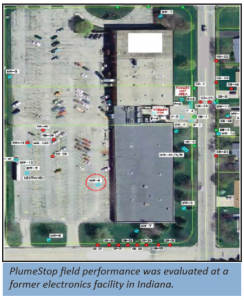
Project Summary
An evaluation of PlumeStop performance was conducted on a section of a mixed chlorinated solvent plume (cVOC) comprising trichloroethene (TCE – 1,390 μg/L) and 1,1,1-trichlorotethane (TCA, 3,550 μg/L) at a former electronics facility in Indiana. PlumeStop was applied in conjunction with the controlled-release electron donor, Hydrogen Release Compound (HRC®). Post-treatment solvent concentrations in groundwater were reduced in two weeks by 92% at the first sampling round. Concentrations were reduced by 99% by the second sampling round (one month) and 99.9% by the third sampling round (two months). No cVOCs were detected above analytical thresholds (<5μg/L) after three months. Source area treatment activities are being monitored for closure and the results are being evaluated as a potential larger scale plume treatment option.
Remediation Approach
PlumeStop was applied perpendicularly to the groundwater flow using 10 direct-push injections around a central monitoring point. Approximately 180 pounds of HRC was applied into three injection points.
REGENESIS Solution Applied
PlumeStop is an innovative in situ remediation technology designed to rapidly reduce contaminant concentrations, stop migrating plumes, eliminate contaminant rebound, achieve stringent clean-up standards and treat back-diffusing contaminants. PlumeStop provides a unique colloidal biomatrix platform which rapidly sorbs contaminants out of the dissolved-phase. Once contaminants are concentrated within the PlumeStop biomatrix, they can be completely biodegraded in place using compatible REGENESIS bioremediation products.
HRC is a controlled release, electron donor material, that when hydrated, is specifically designed to produce a controlled release of soluble lactate. The newly available lactic acid is highly efficient for the production of dissolved hydrogen to fuel anaerobic biodegradation processes in soil and groundwater.
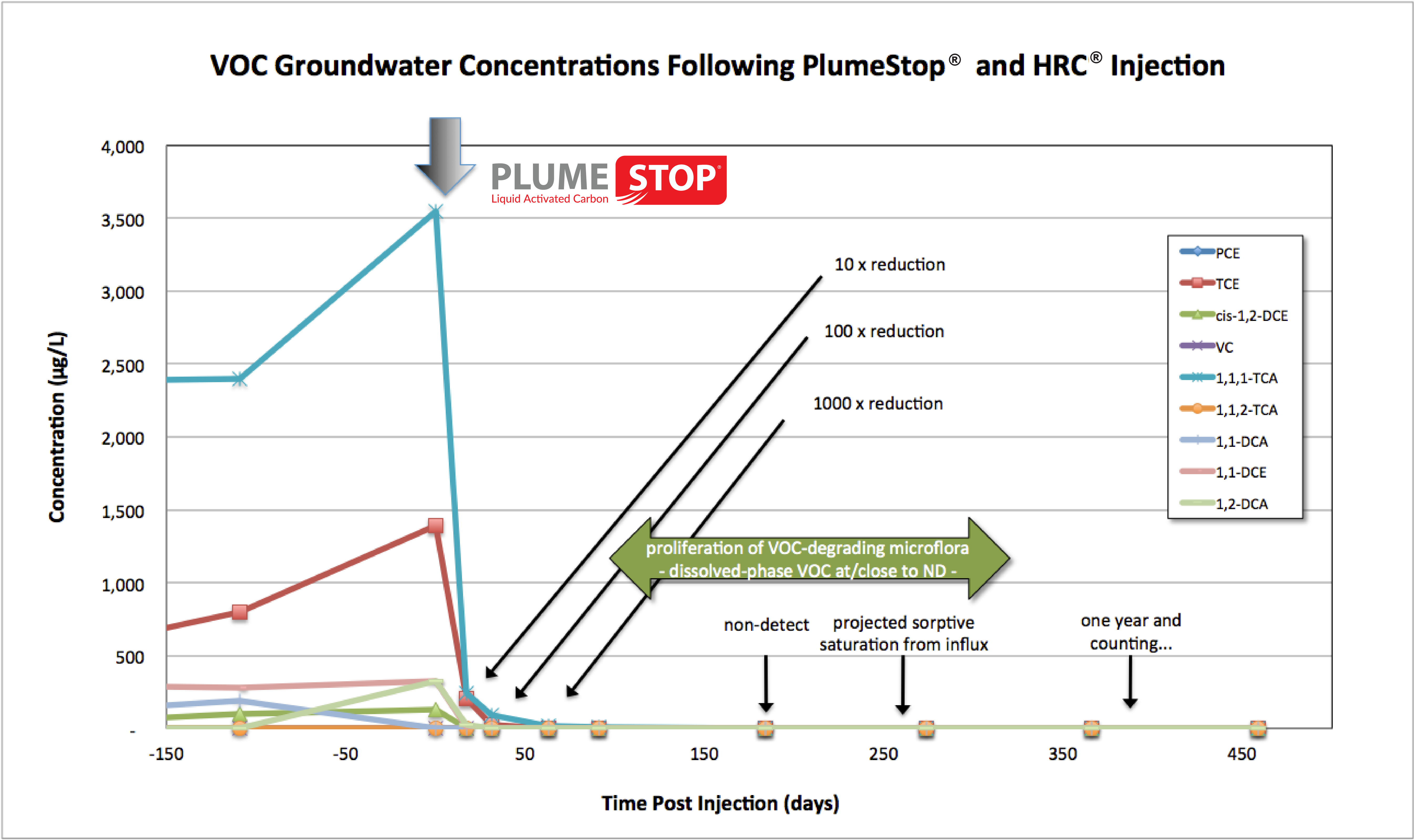
Results
Using a combined remedy approach, the application of PlumeStop and HRC successfully reduced contaminant levels to non-detect and positioned PlumeStop as a viable solution for larger scale projects.
Chemical Oxidation of VOCs – Ex Situ Soil Treatment
Objective
This pilot scale study designed and undertaken by RemedX compared chlorinated hydrocarbon (CHC) destruction by three chemical oxidant additions: solid permanganate, permanganate solution and RegenOx™ under identical treatment conditions. Treatment effectiveness of the additions were compared with each other and with an oxidant-free (water only) control to quantify physical losses such as volatilization during soil mixing. The results from this pilot study will be used to evaluate the feasibility of a full scale ex situ soil treatment application.
1.SOIL HOMOGENIZATION
An excavator mixed the bulk soil.

2. SOIL SPLIT INTO 4 SKIPS
The bulk soil was split and labelled by oxidant treatment.
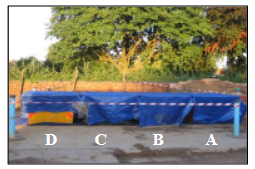
Baseline Sampling
Baseline samples were obtained with a hand auger at 0.15 m depth and field PID readings were taken to confirm homogenization. For each skip, 2 composite samples of 5 prior samples were analyzed for Volatile Organic Compounds (VOCs), Semi-Volatile Organic Compounds (sVOCs), Soil Moisture, Total Organic Carbon (TOC) and grain size. The baseline sampling indicated the soil homogenization process had been effective.
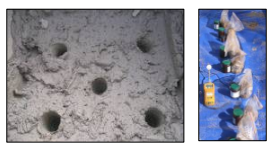
Oxidant Delivery and Soil Mixing
In Skip A, permanganate powder was added and mixed with the excavator. In Skip B, permanganate solution was sprayed and mixed with the excavator. In Skip C, RegenOx™ oxidant powder (Part A) and RegenOx™ activator gel (Part B) were added by hand and then mixed with the excavator. Skip D was the untreated control.
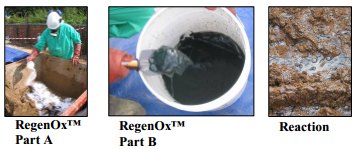
Results
Little or no reduction of any contaminant was observed in either the permanganate solution treatment or the control over the 12 day test period. In contrast, significant reductions in trichloroethene (TCE) and cis-1,2 dichloroethene (DCE) were measured in Skips A (permanganate power) and Skip C (RegenOx™). Significant reductions of perchloroethene (PCE) and trichloroethane (TCA) were also observed in Skip C (RegenOx™) as compared with the other treatments. This was most marked for TCA where an 80% reduction was observed in the RegenOx™ treatment whilst other treatments did not differ significantly from the control (no treatment). The likely reason for unsatisfactory results in Skip B (permanganate solution) was the limited amount of oxidant delivered due to the high moisture content of the soil. The results showed no significant changes in total organic carbon (TOC) and moisture in any of the samples, regardless of treatment.
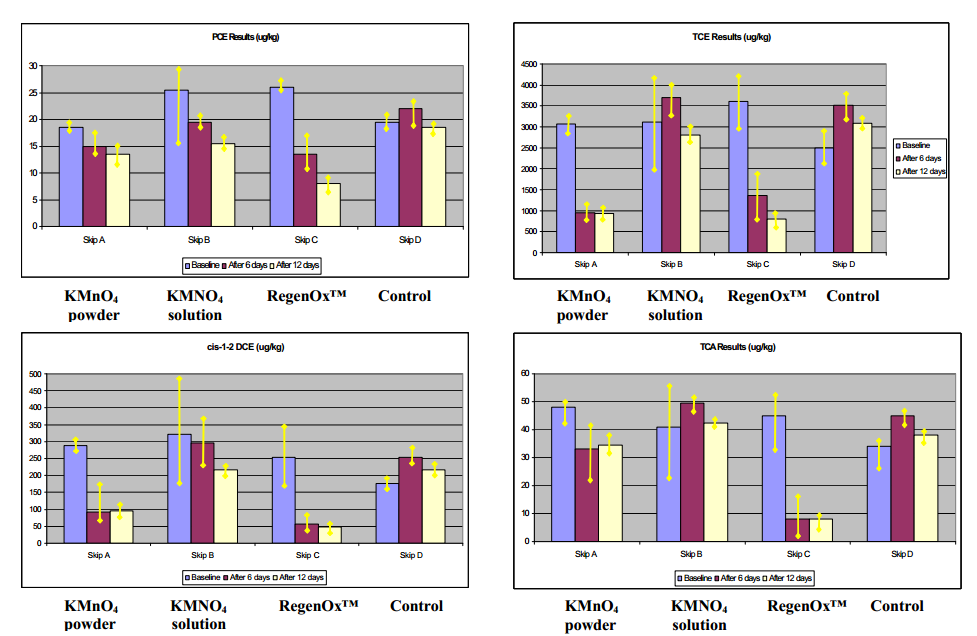
CONCLUSIONS
- RegenOx™ can be effectively used for ex situsoil treatment with less material handling problems than liquid permanganate solution.
- Both Skip A (powdered permanganate) and Skip C (RegenOx™) showed good reductions of TCE and DCE.
- RegenOx™ treated a wider range of CHCs than permanganate, with statistically better results for DCE, PCE
- and TCA and evidence of on-going contaminant reduction through the test period.

 Americas
Americas Europe
Europe Français
Français Deutsch
Deutsch Italiano
Italiano Español
Español

